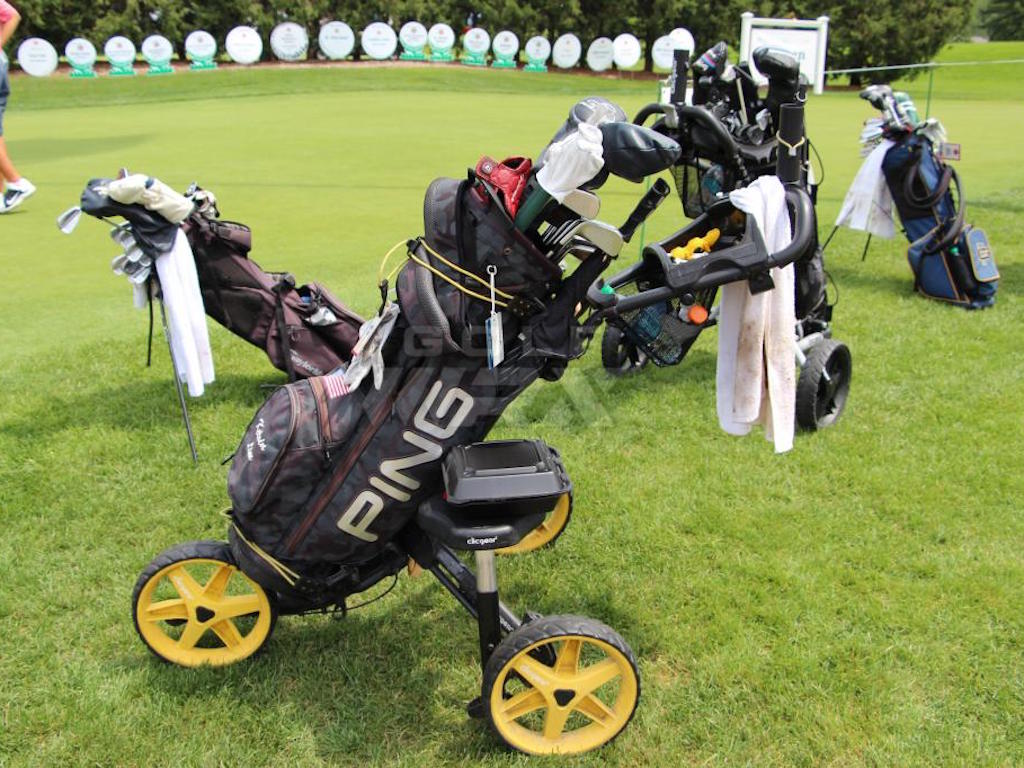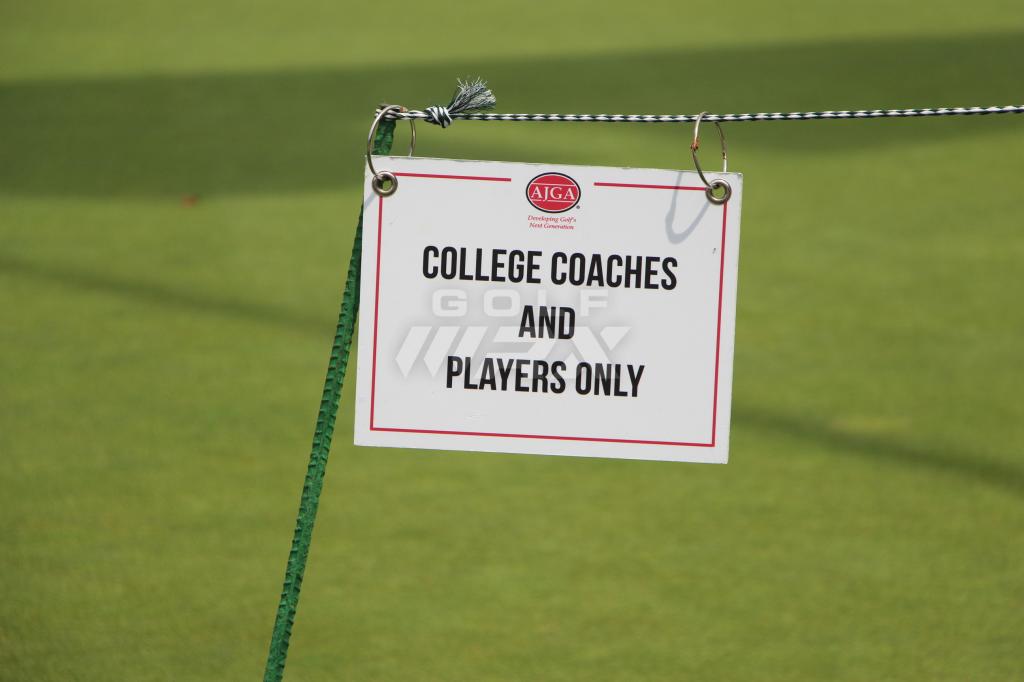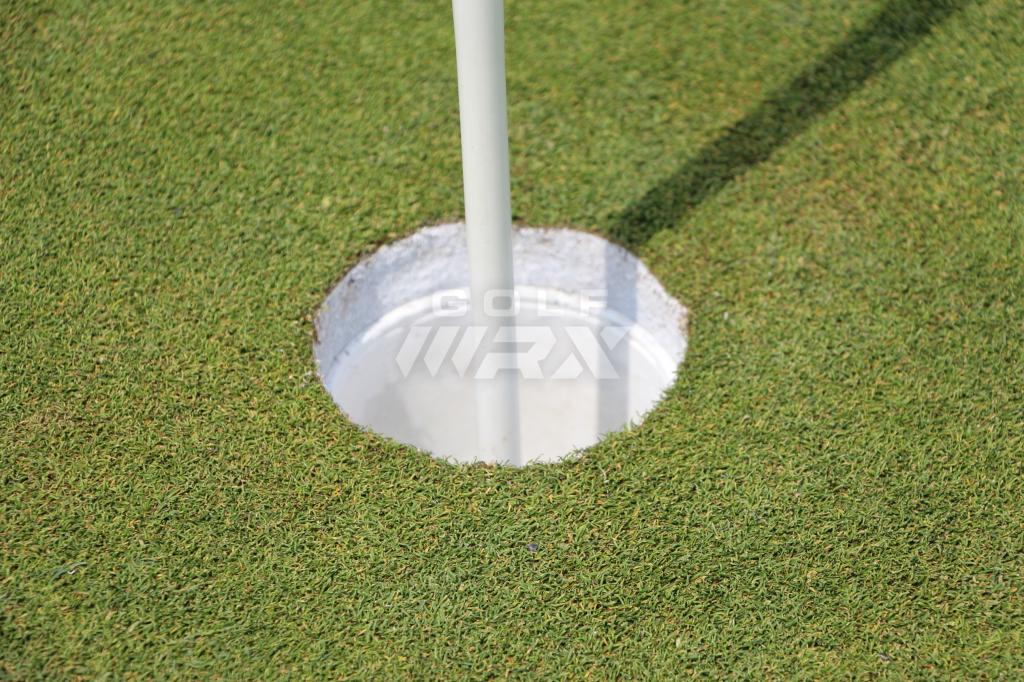Opinion & Analysis
13 Revealing Photos from an AJGA golf event

The American Junior Golf Association (AJGA) is a breeding ground for college golfers; according to its mission statement, the AJGA is a “nonprofit organization dedicated to the overall growth and development of young men and women who aspire to earn college golf scholarships through competitive junior golf.” Some of the best juniors in the country/world collect at AJGA golf events to compete, hone their competitive skills, and also to showcase their talents to college recruiters who use AJGA scores, finishes and performances to evaluate prospective student-athletes. They also pay a lot of money to play in these events — this particular 54-hole event cost $295 entry fee (plus any travel, lodging and practice rounds).
Name a player on the PGA Tour, and chances are he played in AJGA events as a junior… Tiger Woods, Phil Mickelson, Sergio Garcia, Bubba Watson, Dustin Johnson, Jordan Spieth, Rickie Fowler, whoever you can think of really. Even yours truly, the GolfWRX Editor, once upon a time played in AJGA events. But that was over 10 years ago now, and I wanted to revisit an AJGA event to see how things have changed.
So, recently, I went to the AJGA Junior at Forest Lake presented by Tom Holzer Ford in Bloomfield Hills, Michigan to cover the event. Below are my takeaways.
Listen to the Two Guys Talking Golf podcast for more of my opinions and takeaways!
1) Treated like Tour players

Each of the players are given individual lockers with their names on them for the week. I’ve always been a change-the-shoes-in-the-parking-lot kind of guy myself, but this is a nice touch.
2) It’s official

Like most professional events, the AJGA events have tents, waters, granola bars, tees, scorecards and pencils on the first tee. And they announce your name/hometown, which is always intimidating.

3) Sponsors

As a popular junior golf organization, the AJGA attracts a number of big-name sponsors.

But the most important sponsor is Care for the Course. These kids hit pretty much every green, so repairing ball marks on the green is crucial.
4) College Coaches do show up

During the first round of a random AJGA event in Michigan, there were a number of college coaches on site, representing DI, DII and DIII colleges. While that does mean added pressure for the 12-18 year old kids, it also means that playing well in these events could very well land you a scholarship. After talking with a few of the college coaches, however, it’s often positive body language even after a double bogey that can really impress coaches. Juniors, keep that one in mind.
5) Push carts, or carry bags?

By my estimation, about 70 percent of the competitors used pull carts. Back in my days of AJGA golf, it was rare to find 1 or 2 juniors using push carts. Why the change? Well, it seems kids have smartened up. Speaking with a few competitors, it seems they prefer push carts over carry bags because it adds additional space for water bottles, scorecards, weather gear, umbrellas, and it’s easier on your body during long rounds.
6) Yea, these kids are good

16-year-old Maxwell Moldovan shot a 9-under 62 (and course record) in the first round of the event. He made 9 birdies against 9 pars. Speaking with him after the round, he seemed unfazed by the 62, instead enjoying his position and plotting his first AJGA victory. These kids just have no fear. (Also, live scoring is awesome).

The new course record holder was gaming a mixed iron set of Titleist CBs and MBs (as shown above), and was using custom Titleist SM7 wedges stamped with “M2,” surely a play on his initials. And yes, he’s pro-push cart.
7) The most nerve-racking moment in the round

Have you ever shot a great round in a tournament, then been nervous you’d make a stupid scoring mistake and get DQ’d, so you go over your round multiple times to confirm the scores? I know I can’t be alone.
8) Tough track

The quirky, par-71 golf course measured just 6,283 yards on the scorecard — AJGA employees estimate most events are played between 6,800 and 7,200 yards — but many of the holes seemed to either take driver out of the players’ hands (although they typically hit driver anyway), or at least made hitting driver very difficult.

Plus, they had pins tucked pretty good. After the round, participants estimated the greens were running at about a 12 on the stimp, and one player said “the greens were some of the hardest I’ve putted on all summer.”

Also, painted dirt inside the cups goes a long way to making the tournament feel more official. I thought they painted cups white so the TV cameras could better see where the hole is, and as far as I know this AJGA event wasn’t televised, but hey, it looks cool.
9) Keeping up

The AJGA keeps players moving, timing them on a number of holes at “timing stations,” and handing out warnings for slow play. Enough warnings and the group gets reprimanded with a penalty stroke. There’s not nearly as much leeway out here as on the PGA Tour… they do actually hand out penalty strokes, and the participants seemed well aware of that.
10) Cross-hand putting grips

Everyone out there was using a cross-handed putting grip. Literally, everyone I saw was putting cross-handed.
11) Rules officials

Like any big tournament, rules officials swarm the course. This kid hooked his tee shot up against an outhouse, and resolved the situation with a volunteer and a rules official. As soon as he hit his shot, he asked to make sure “Are we still on pace?” That’s the timing stations doing their jobs.
12) Parents

Parents can be seen all over the course, following their son/daughter, grinding over each shot just as hard or harder than the players themselves.
“I’m holding up OK, but my husband might have a heart attack,” one mother of a first-time AJGA participant told me. The pressure is real out there for everyone involved.
13) And that’s all she wrote

Opinion & Analysis
The 2 primary challenges golf equipment companies face

As the editor-in-chief of this website and an observer of the GolfWRX forums and other online golf equipment discourse for over a decade, I’m pretty well attuned to the grunts and grumbles of a significant portion of the golf equipment purchasing spectrum. And before you accuse me of lording above all in some digital ivory tower, I’d like to offer that I worked at golf courses (public and private) for years prior to picking up my pen, so I’m well-versed in the non-degenerate golf equipment consumers out there. I touched (green)grass (retail)!
Complaints about the ills of and related to the OEMs usually follow some version of: Product cycles are too short for real innovation, tour equipment isn’t the same as retail (which is largely not true, by the way), too much is invested in marketing and not enough in R&D, top staffer X hasn’t even put the new driver in play, so it’s obviously not superior to the previous generation, prices are too high, and on and on.
Without digging into the merits of any of these claims, which I believe are mostly red herrings, I’d like to bring into view of our rangefinder what I believe to be the two primary difficulties golf equipment companies face.
One: As Terry Koehler, back when he was the CEO of Ben Hogan, told me at the time of the Ft Worth irons launch, if you can’t regularly hit the golf ball in a coin-sized area in the middle of the face, there’s not a ton that iron technology can do for you. Now, this is less true now with respect to irons than when he said it, and is less and less true by degrees as the clubs get larger (utilities, fairways, hybrids, drivers), but there remains a great deal of golf equipment truth in that statement. Think about it — which is to say, in TL;DR fashion, get lessons from a qualified instructor who will teach you about the fundamentals of repeatable impact and how the golf swing works, not just offer band-aid fixes. If you can’t repeatably deliver the golf club to the golf ball in something resembling the manner it was designed for, how can you expect to be getting the most out of the club — put another way, the maximum value from your investment?
Similarly, game improvement equipment can only improve your game if you game it. In other words, get fit for the clubs you ought to be playing rather than filling the bag with the ones you wish you could hit or used to be able to hit. Of course, don’t do this if you don’t care about performance and just want to hit a forged blade while playing off an 18 handicap. That’s absolutely fine. There were plenty of members in clubs back in the day playing Hogan Apex or Mizuno MP-32 irons who had no business doing so from a ballstriking standpoint, but they enjoyed their look, feel, and complementary qualities to their Gatsby hats and cashmere sweaters. Do what brings you a measure of joy in this maddening game.
Now, the second issue. This is not a plea for non-conforming equipment; rather, it is a statement of fact. USGA/R&A limits on every facet of golf equipment are detrimental to golf equipment manufacturers. Sure, you know this, but do you think about it as it applies to almost every element of equipment? A 500cc driver would be inherently more forgiving than a 460cc, as one with a COR measurement in excess of 0.83. 50-inch shafts. Box grooves. And on and on.
Would fewer regulations be objectively bad for the game? Would this erode its soul? Fortunately, that’s beside the point of this exercise, which is merely to point out the facts. The fact, in this case, is that equipment restrictions and regulations are the slaughterbench of an abundance of innovation in the golf equipment space. Is this for the best? Well, now I’ve asked the question twice and might as well give a partial response, I guess my answer to that would be, “It depends on what type of golf you’re playing and who you’re playing it with.”
For my part, I don’t mind embarrassing myself with vintage blades and persimmons chasing after the quasi-spiritual elevation of a well-struck shot, but that’s just me. Plenty of folks don’t give a damn if their grooves are conforming. Plenty of folks think the folks in Liberty Corner ought to add a prison to the museum for such offences. And those are just a few of the considerations for the amateur game — which doesn’t get inside the gallery ropes of the pro game…
Different strokes in the game of golf, in my humble opinion.
Anyway, I believe equipment company engineers are genuinely trying to build better equipment year over year. The marketing departments are trying to find ways to make this equipment appeal to the broadest segment of the golf market possible. All of this against (1) the backdrop of — at least for now — firm product cycles. And golfers who, with their ~15 average handicap (men), for the most part, are not striping the golf ball like Tiger in his prime and seem to have less and less time year over year to practice and improve. (2) Regulations that massively restrict what they’re able to do…
That’s the landscape as I see it and the real headwinds for golf equipment companies. No doubt, there’s more I haven’t considered, but I think the previous is a better — and better faith — point of departure when formulating any serious commentary on the golf equipment world than some of the more cynical and conspiratorial takes I hear.
Agree? Disagree? Think I’m worthy of an Adam Hadwin-esque security guard tackle? Let me know in the comments.
@golfoncbs The infamous Adam Hadwin tackle ? #golf #fyp #canada #pgatour #adamhadwin ? Ghibli-style nostalgic waltz – MaSssuguMusic
Podcasts
Fore Love of Golf: Introducing a new club concept

Episode #16 brings us Cliff McKinney. Cliff is the founder of Old Charlie Golf Club, a new club, and concept, to be built in the Florida panhandle. The model is quite interesting and aims to make great, private golf more affordable. We hope you enjoy the show!
Opinion & Analysis
On Scottie Scheffler wondering ‘What’s the point of winning?’

Last week, I came across a reel from BBC Sport on Instagram featuring Scottie Scheffler speaking to the media ahead of The Open at Royal Portrush. In it, he shared that he often wonders what the point is of wanting to win tournaments so badly — especially when he knows, deep down, that it doesn’t lead to a truly fulfilling life.
View this post on Instagram
“Is it great to be able to win tournaments and to accomplish the things I have in the game of golf? Yeah, it brings tears to my eyes just to think about it because I’ve literally worked my entire life to be good at this sport,” Scheffler said. “To have that kind of sense of accomplishment, I think, is a pretty cool feeling. To get to live out your dreams is very special, but at the end of the day, I’m not out here to inspire the next generation of golfers. I’m not out here to inspire someone to be the best player in the world, because what’s the point?”
Ironically — or perhaps perfectly — he went on to win the claret jug.
That question — what’s the point of winning? — cuts straight to the heart of the human journey.
As someone who’s spent over two decades in the trenches of professional golf, and in deep study of the mental, emotional, and spiritual dimensions of the game, I see Scottie’s inner conflict as a sign of soul evolution in motion.
I came to golf late. I wasn’t a junior standout or college All-American. At 27, I left a steady corporate job to see if I could be on the PGA Tour starting as a 14-handicap, average-length hitter. Over the years, my journey has been defined less by trophies and more by the relentless effort to navigate the deeply inequitable and gated system of professional golf — an effort that ultimately turned inward and helped me evolve as both a golfer and a person.
One perspective that helped me make sense of this inner dissonance around competition and our culture’s tendency to overvalue winning is the idea of soul evolution.
The University of Virginia’s Division of Perceptual Studies has done extensive research on reincarnation, and Netflix’s Surviving Death (Episode 6) explores the topic, too. Whether you take it literally or metaphorically, the idea that we’re on a long arc of growth — from beginner to sage elder — offers a profound perspective.
If you accept the premise literally, then terms like “young soul” and “old soul” start to hold meaning. However, even if we set the word “soul” aside, it’s easy to see that different levels of life experience produce different worldviews.
Newer souls — or people in earlier stages of their development — may be curious and kind but still lack discernment or depth. There is a naivety, and they don’t yet question as deeply, tending to see things in black and white, partly because certainty feels safer than confronting the unknown.
As we gain more experience, we begin to experiment. We test limits. We chase extreme external goals — sometimes at the expense of health, relationships, or inner peace — still operating from hunger, ambition, and the fragility of the ego.
It’s a necessary stage, but often a turbulent and unfulfilling one.
David Duval fell off the map after reaching World No. 1. Bubba Watson had his own “Is this it?” moment with his caddie, Ted Scott, after winning the Masters.
In Aaron Rodgers: Enigma, reflecting on his 2011 Super Bowl win, Rodgers said:
“Now I’ve accomplished the only thing that I really, really wanted to do in my life. Now what? I was like, ‘Did I aim at the wrong thing? Did I spend too much time thinking about stuff that ultimately doesn’t give you true happiness?’”
Jim Carrey once said, “I think everybody should get rich and famous and do everything they ever dreamed of so they can see that it’s not the answer.”
Eventually, though, something shifts.
We begin to see in shades of gray. Winning, dominating, accumulating—these pursuits lose their shine. The rewards feel more fleeting. Living in a constant state of fight-or-flight makes us feel alive, yes, but not happy and joyful.
Compassion begins to replace ambition. Love, presence, and gratitude become more fulfilling than status, profits, or trophies. We crave balance over burnout. Collaboration over competition. Meaning over metrics.
Interestingly, if we zoom out, we can apply this same model to nations and cultures. Countries, like people, have a collective “soul stage” made up of the individuals within them.
Take the United States, for example. I’d place it as a mid-level soul: highly competitive and deeply driven, but still learning emotional maturity. Still uncomfortable with nuance. Still believing that more is always better. Despite its global wins, the U.S. currently ranks just 23rd in happiness (as of 2025). You might liken it to a gifted teenager—bold, eager, and ambitious, but angsty and still figuring out how to live well and in balance. As much as a parent wants to protect their child, sometimes the child has to make their own mistakes to truly grow.
So when Scottie Scheffler wonders what the point of winning is, I don’t see someone losing strength.
I see someone evolving.
He’s beginning to look beyond the leaderboard. Beyond metrics of success that carry a lower vibration. And yet, in a poetic twist, Scheffler did go on to win The Open. But that only reinforces the point: even at the pinnacle, the question remains. And if more of us in the golf and sports world — and in U.S. culture at large — started asking similar questions, we might discover that the more meaningful trophy isn’t about accumulating or beating others at all costs.
It’s about awakening and evolving to something more than winning could ever promise.



















Steven McGee
Aug 14, 2018 at 9:33 am
Thanks for promoting the AJGA and our club..A lot goes into these events, but the best part are the kids ALL are polite and respectful a wonderful example of the future.
David Bassett
Aug 10, 2018 at 9:03 pm
I’ve played a lot of great courses, but Forest Lake’s are some of the fastest I’ve ever seen. Really liked this little feature, Andrew
Alex Podressoff
Aug 10, 2018 at 2:53 pm
I’ve worked dozens of AJGA tournaments as a volunteer in various capacities including scoring and timing. These kids are incredible: Great golfers, polite, striving to always be better. As I told one young lady, on your worst day, you are probably a better golfer than I am on my best day. Hats off to the players, the host courses, and of course the AJGA staff. And I should say that the parents are great in supporting their children. Parents and players never fail to say “thank you for volunteering”.
ogo
Aug 9, 2018 at 1:55 pm
Abolish caddies and make the tour pros carry their own bags. Oh, and no green-reading charts too!
IMO
Aug 9, 2018 at 11:22 pm
+1
4right
Aug 9, 2018 at 11:25 pm
AJGA has timing stations, so should the tour… Most tour players played AJGA so it wouldn’t be such a shock…